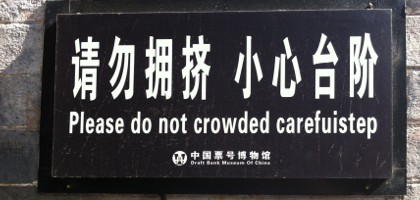 As I wrote in the previous episode of the blog, I spent the last weeks touring a far away country: China. That had one disadvantage, I missed most of the action from the Europeans. The timing of the Europeans looked great, with play starting around 5pm local time, which is a nice time to sit down and relax with a beer after a day of sightseeing while watching a few hands before dinner. Unfortunately, the Internet in hotels was so slow that it could not even keep up with Muller playing a hand. There were a few exceptions, such as the Denmark-Monaco match described below.
As I wrote in the previous episode of the blog, I spent the last weeks touring a far away country: China. That had one disadvantage, I missed most of the action from the Europeans. The timing of the Europeans looked great, with play starting around 5pm local time, which is a nice time to sit down and relax with a beer after a day of sightseeing while watching a few hands before dinner. Unfortunately, the Internet in hotels was so slow that it could not even keep up with Muller playing a hand. There were a few exceptions, such as the Denmark-Monaco match described below.
Before I start on bridge, let me tell you that China is a great country: lots of interesting sights, good food (not even remotely resembling what you get at the local Chinese take-away) and very friendly people. Unfortunately their English is usually quite bad, and after 3 weeks, I still couldn’t make heads or tails of the local language, which makes communicating hard.
What is even worse than the spoken English, are the signs in the street: they appear to be translated by a person with a dictionary but no knowledge of the language. A couple of examples. First the the one on top of the page, somewhere in a museum in Pingyao. I’m still not sure what it is supposed to mean, but to be honest, our local chinese guide could not understand the chinese version either. Her best guess was that you had to be careful with the stairs when the room was full of people. Unfortunately, there were no stairs in sight.
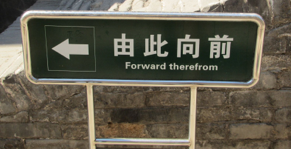 Then we had these 2. “Forward therefrom” is clearly a translation without any knowledge of the language, even though you can guess what it is supposed to mean.
Then we had these 2. “Forward therefrom” is clearly a translation without any knowledge of the language, even though you can guess what it is supposed to mean.
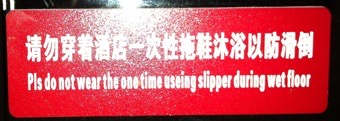 Next there was the one on the left. Even if you ignore the spelling error in “useing”, what is an “e” if an US-vice-president adds one to “potatoe” and gets away with it, it isn’t clear what you are not supposed to be doing.
Next there was the one on the left. Even if you ignore the spelling error in “useing”, what is an “e” if an US-vice-president adds one to “potatoe” and gets away with it, it isn’t clear what you are not supposed to be doing.
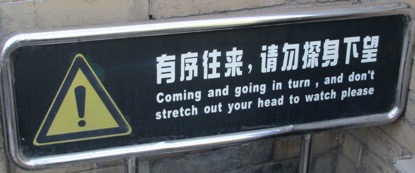 Finally, the best one. Not only is it totally unclear what to do, also note the spacing around the comma. Dots, commas and explanation marks are unknown in Chinese and it isn’t clear how to put them in the text. The same goes for hyphenation. You cannot hyphenate a Chinese character. In English, that is different but if you are not familiar with the rules it can lead to funny results. Like “the” hyphenated to “t- he”. If you don’t look carefully, it leads to funny situations.
Finally, the best one. Not only is it totally unclear what to do, also note the spacing around the comma. Dots, commas and explanation marks are unknown in Chinese and it isn’t clear how to put them in the text. The same goes for hyphenation. You cannot hyphenate a Chinese character. In English, that is different but if you are not familiar with the rules it can lead to funny results. Like “the” hyphenated to “t- he”. If you don’t look carefully, it leads to funny situations.

 Back to bridge. As I wrote, I had an occasional hour to watch some of the hands from the Europeans. One of the matches, I watched on BBO, was Denmark versus Monaco. Monaco recently became a major force in international bridge when the sponsor Pierre Zimmerman hired 2 of the world strongest pairs and somehow managed to make them eligible to play for the tiny country. So, this match featured Fantoni-Nunes and Helness-Helgemo, playing against a solid Danish team.
Back to bridge. As I wrote, I had an occasional hour to watch some of the hands from the Europeans. One of the matches, I watched on BBO, was Denmark versus Monaco. Monaco recently became a major force in international bridge when the sponsor Pierre Zimmerman hired 2 of the world strongest pairs and somehow managed to make them eligible to play for the tiny country. So, this match featured Fantoni-Nunes and Helness-Helgemo, playing against a solid Danish team.
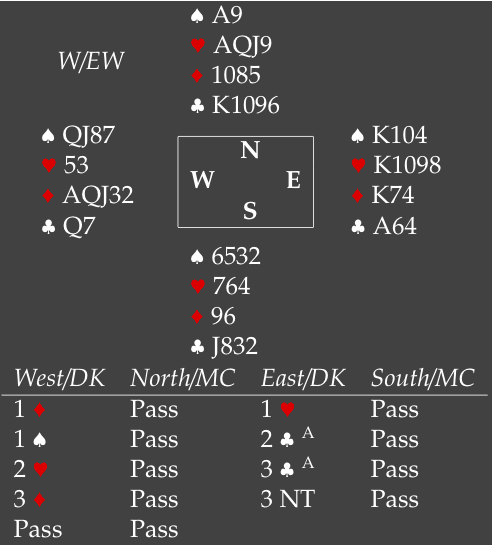 On this deal, the Danes gave much clearer signals than any of the Chinese signs above. Unfortunately, it did not do them much good. First the open room. The Danish EW play a strong club system where 1♦ followed by 1♠ shows an unbalanced hand, either 5♦-4♠ or 444-1♥. 2♣ was 4th suit forcing and 3♣ asked again. I don’t quite understand the bids from west. Even if you have shown 5♦-4♠, it doesn’t feel right to support hearts on a small doubleton. And if 2♥ would show 6♦-4♠, then I think that there is a problem with your system. After 2♥, partner may think you have a 4♠-3♥-5♦-1♣ hand. It also looks better to show your partial club-stopper over 3♣, having denied a full stop a round earlier. That would have right-sided the contract and also gotten you to ♣Jxx. After all this bidding, it was quite clear to south what to lead: a small club. That set the contract by a trick.
On this deal, the Danes gave much clearer signals than any of the Chinese signs above. Unfortunately, it did not do them much good. First the open room. The Danish EW play a strong club system where 1♦ followed by 1♠ shows an unbalanced hand, either 5♦-4♠ or 444-1♥. 2♣ was 4th suit forcing and 3♣ asked again. I don’t quite understand the bids from west. Even if you have shown 5♦-4♠, it doesn’t feel right to support hearts on a small doubleton. And if 2♥ would show 6♦-4♠, then I think that there is a problem with your system. After 2♥, partner may think you have a 4♠-3♥-5♦-1♣ hand. It also looks better to show your partial club-stopper over 3♣, having denied a full stop a round earlier. That would have right-sided the contract and also gotten you to ♣Jxx. After all this bidding, it was quite clear to south what to lead: a small club. That set the contract by a trick.
 Over to the other room. Here Schaltz, north for Denmark, tried to help partner find the right lead against 3NT by overcalling on a 4 card suit. It didn’t work out. Helness for Monaco bid what he thought he could make and south followed orders by leading a heart. ♥7, ♥5, ♥J, ♥K. Declarer knocked out the ♠A and soon claimed 10 tricks. 12 imp’s, with both actions by the Danes backfiring.
Over to the other room. Here Schaltz, north for Denmark, tried to help partner find the right lead against 3NT by overcalling on a 4 card suit. It didn’t work out. Helness for Monaco bid what he thought he could make and south followed orders by leading a heart. ♥7, ♥5, ♥J, ♥K. Declarer knocked out the ♠A and soon claimed 10 tricks. 12 imp’s, with both actions by the Danes backfiring.
There are very few ways to score +1000 and usually, it will translate to a few imp’s gain. Here we have such a score.
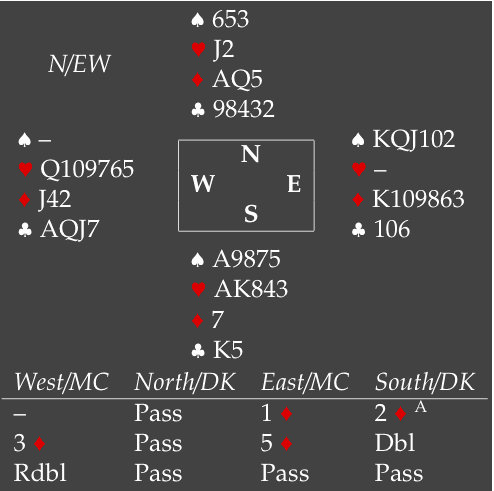 East decided to open his weak 2-suiter with 1♦ and south overcalled 2♦ to show majors. West now has an interesting problem, you like to double 2♥ if the opponents ever bid that but it can be expected that the opponents will run to spades. Helgemo bid 3♦, which looks strange to me considering that 1♦ can be a 3-card suit and the hand appears to be way to strong for a simple raise. Helness raised to game and south though he had extra’s for his bidding so-far. West thought so as well.
East decided to open his weak 2-suiter with 1♦ and south overcalled 2♦ to show majors. West now has an interesting problem, you like to double 2♥ if the opponents ever bid that but it can be expected that the opponents will run to spades. Helgemo bid 3♦, which looks strange to me considering that 1♦ can be a 3-card suit and the hand appears to be way to strong for a simple raise. Helness raised to game and south though he had extra’s for his bidding so-far. West thought so as well.
The play was fairly straightforward. South led the ♥K, ruffed. Declarer followed with the ♠K, ducked by south. Next a club was played to the ♣J. When this held, it was clear that north must have the long trumps and there was nothing that the defense could do to stop the overtrick. 5♦xx making 6, for +1000.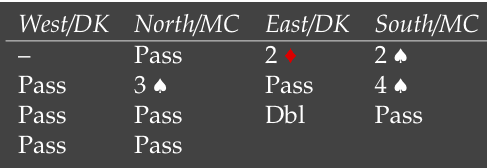
A pick-up for EW? No, look at the events in the other room. East started proceedings with a Wilkosz 2♦ bid, showing a major-minor 2-suiter, 5-10 hcp or thereabout. This convention is brown-sticker and disallowed in most events. The Europeans are an exception. South made a normal looking 2♠ overcall, north a normal raise and south thought he had extra’s. I’m not sure if I agree with him, you know that east has a long major. If that is spades, that is bad, if that is hearts, then it will be hard to set up your second suit. 5 undertricks later, he must have agreed with me. -1400 meant that the +!000 from the other room translated to a 9 imp loss for Monaco. Not exactly the result you expect when you score +1000 yourself.
It should be noted though that Monaco simply continued to play good bridge after this disaster, eventually winning the match 25-5.
